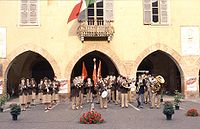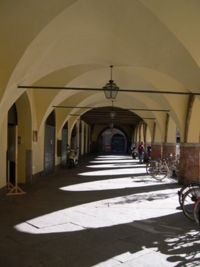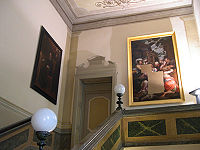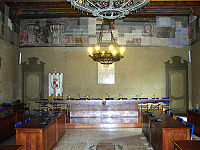
Gallavresi Palace
Encyclopedia




Lombardy
Lombardy is one of the 20 regions of Italy. The capital is Milan. One-sixth of Italy's population lives in Lombardy and about one fifth of Italy's GDP is produced in this region, making it the most populous and richest region in the country and one of the richest in the whole of Europe...
, northern Italy
Italy
Italy , officially the Italian Republic languages]] under the European Charter for Regional or Minority Languages. In each of these, Italy's official name is as follows:;;;;;;;;), is a unitary parliamentary republic in South-Central Europe. To the north it borders France, Switzerland, Austria and...
; it has been see to the town administration since 1947.
History
It is not precisely known when the palace was built, although a valid terminus post quemTerminus post quem
Terminus post quem and terminus ante quem specify approximate dates for events...
is given by the International Gothic
International Gothic
International Gothic is a phase of Gothic art which developed in Burgundy, Bohemia, France and northern Italy in the late 14th century and early 15th century...
style of the arch
Arch
An arch is a structure that spans a space and supports a load. Arches appeared as early as the 2nd millennium BC in Mesopotamian brick architecture and their systematic use started with the Ancient Romans who were the first to apply the technique to a wide range of structures.-Technical aspects:The...
es making up the portico
Portico
A portico is a porch leading to the entrance of a building, or extended as a colonnade, with a roof structure over a walkway, supported by columns or enclosed by walls...
es on the facade
Facade
A facade or façade is generally one exterior side of a building, usually, but not always, the front. The word comes from the French language, literally meaning "frontage" or "face"....
, according to which the construction date could be in the second half of the 13th century (when the Gothic style spread in Lombardy) at earliest. Anyway, the palace was probably erected onto a pre-existing building.
The palace began hosting the town hall during the first half of the 14th century; through the centuries it was then ceded to private families, starting from the Marquisses from the Sforza family, and then to the Villani Marquisses and to the Schizzis. The last owners were the Bellinzaghis and the Gallavresis, who kept the property until the first half of the 20th century.
Just after the end of World War II
World War II
World War II, or the Second World War , was a global conflict lasting from 1939 to 1945, involving most of the world's nations—including all of the great powers—eventually forming two opposing military alliances: the Allies and the Axis...
, the town administration bought back the palace to move the town hall there, from the old building in via Mangone.
The palace underwent a heavy restructure in 1981; the restructure of the facade revealed characteristic features which are typical of the International Gothic style.
Structure
The palace lies in piazza Garibaldi, the central square in the old town; it is surrounded by the pedestrian streets of the historical centre an all the other sides.By looking at old maps, one can easily detect the existence of two ancient suspended pathways connecting the palace to two neighbouring buildings, home to the podestà
Podestà
Podestà is the name given to certain high officials in many Italian cities, since the later Middle Ages, mainly as Chief magistrate of a city state , but also as a local administrator, the representative of the Emperor.The term derives from the Latin word potestas, meaning power...
and the governor
Governor
A governor is a governing official, usually the executive of a non-sovereign level of government, ranking under the head of state...
; these were destroyed in 1850, when Palazzo Gallavresi was owned by the Bellinzaghis.
Facade
Above the porticoes dating back to the 15th century, the facade features marble medals with the faces of four Italian patriots: Giuseppe MazziniGiuseppe Mazzini
Giuseppe Mazzini , nicknamed Soul of Italy, was an Italian politician, journalist and activist for the unification of Italy. His efforts helped bring about the independent and unified Italy in place of the several separate states, many dominated by foreign powers, that existed until the 19th century...
, Giuseppe Garibaldi
Giuseppe Garibaldi
Giuseppe Garibaldi was an Italian military and political figure. In his twenties, he joined the Carbonari Italian patriot revolutionaries, and fled Italy after a failed insurrection. Garibaldi took part in the War of the Farrapos and the Uruguayan Civil War leading the Italian Legion, and...
, Vittorio Emanuele II and Camillo Benso, conte di Cavour. The medals were made between 1884 and 1889.
Between the windows there used to lie the coat of arms of the town marquesses (from the earliest to the last, the Viscontis, the Sforzas, the Villanis and the Schizzis).
Interior
The main characteristic of the interior of the palace is a majestic stairway, featuring a starry sky on the ceiling, leading to the town council hall, in the upper floor. The hall is typically baroque, and is by far the most richly decorated in the building; it features a decorative bend on all four sides, just below the ceiling, with pictures of winged puttiPutto
A putto is a figure of an infant often depicted as a young male. Putti are defined as chubby, winged or wingless, male child figure in nude. Putti are distinct from cherubim, but some English-speakers confuse them with each other, except that in the plural, "the Cherubim" refers to the biblical...
playing instruments. The walls feature baroque frescoes. The floor features a mosaic representing the coat of arms of the town. The entrance of the hall hosts a sculpture of Emilio Gallavresi, who was born and lived in the building and became a member of the Italian parliament
Parliament of Italy
The Parliament of Italy is the national parliament of Italy. It is a bicameral legislature with 945 elected members . The Chamber of Deputies, with 630 members is the lower house. The Senate of the Republic is the upper house and has 315 members .Since 2005, a party list electoral law is being...
as a member of the Italian Socialist Party
Italian Socialist Party
The Italian Socialist Party was a socialist and later social-democratic political party in Italy founded in Genoa in 1892.Once the dominant leftist party in Italy, it was eclipsed in status by the Italian Communist Party following World War II...
; the sculpture was made by Enrico Pancera.

